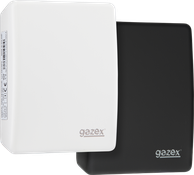Today’s households increasingly use a variety of utilities and industrial gases – from natural gas (methane) and propane-butane, to refrigerants used in air conditioners (such as R410A or R32), to gases formed as products of combustion or air quality indicators, such as carbon monoxide (CO/chad) and carbon dioxide (CO2). Carbon monoxide is a toxic product of incomplete combustion of fuels that can be deadly even in small concentrations. Carbon dioxide, on the other hand, although naturally present in the air, in excess indicates poor ventilation and impaired indoor air quality. Monitoring these substances is crucial not only for the safety of householders, but also for the comfort of life and the efficiency of home installations.
Flammable gases – methane and propane-butane
A leak of natural gas (methane) or propane-butane can lead to dangerous situations such as a fire or explosion. It is therefore crucial not only to detect the presence of gas in the air early, but also to automatically shut off the gas supply to the system in case of danger. Natural gas (methane) or propane-butane detectors can work with solenoid valves that shut off the gas supply immediately, eliminating the risk of serious consequences.
Carbon monoxide – a silent killer
Carbon monoxide (CO/chad), formed during incomplete combustion of fuels, is odorless and invisible, which is why it is often called the „silent killer”. Its emissions most often occur in boiler rooms, kitchens and bathrooms equipped with gas water heaters, as well as in rooms with fireplaces and stoves burning coal, wood or fuel oil. CO detectors installed near potential emission sources are a simple but extremely effective preventive measure that can save lives.
Carbon dioxide
Although carbon dioxide (CO2) is mainly associated with industrial emissions, its high concentration indoors can indicate poor ventilation and reduced air quality. It can cause fatigue, headaches and decreased concentration.
Refrigerants
Air conditioners and heat pumps use refrigerants such as R410A and R32. Although they are more environmentally friendly than older substances, leakage can reduce the efficiency of the unit, as well as pose a risk with prolonged exposure in confined spaces.
Detected substance/property
- Substance/property:
- carbon dioxide (CO2)
- Hazard:
- toxic gas
- TWA (time-weighted average):
- 9000.0 mg/m3
- STEL (short-term exposure limit):
- 27000.0 mg/m3
- Density relative to air:
- 1.52
- Substance/property:
- carbon monoxide (CO)
- Hazard:
- toxic gas
- LEL (lower explosive limit):
- 12.5 %v/v
- TWA (time-weighted average):
- 23.0 mg/m3
- STEL (short-term exposure limit):
- 117.0 mg/m3
- Density relative to air:
- 0.97
- Substance/property:
- liquefied petroleum gas (LPG)
- Hazard:
- explosive gas
- LEL (lower explosive limit):
- 2.1 %v/v
- Density relative to air:
- 1.8
- Substance/property:
- methane (CH4)
- Hazard:
- explosive gas
- LEL (lower explosive limit):
- 4.4 %v/v
- Density relative to air:
- 0.55
- Substance/property:
- refrigerant R32
- Hazard:
- hypoxia, greenhouse gas
- Density relative to air:
- 1.8
- Substance/property:
- refrigerant R410A
- Hazard:
- hypoxia, greenhouse gas
- Density relative to air:
- 15.0
Suggested products

















